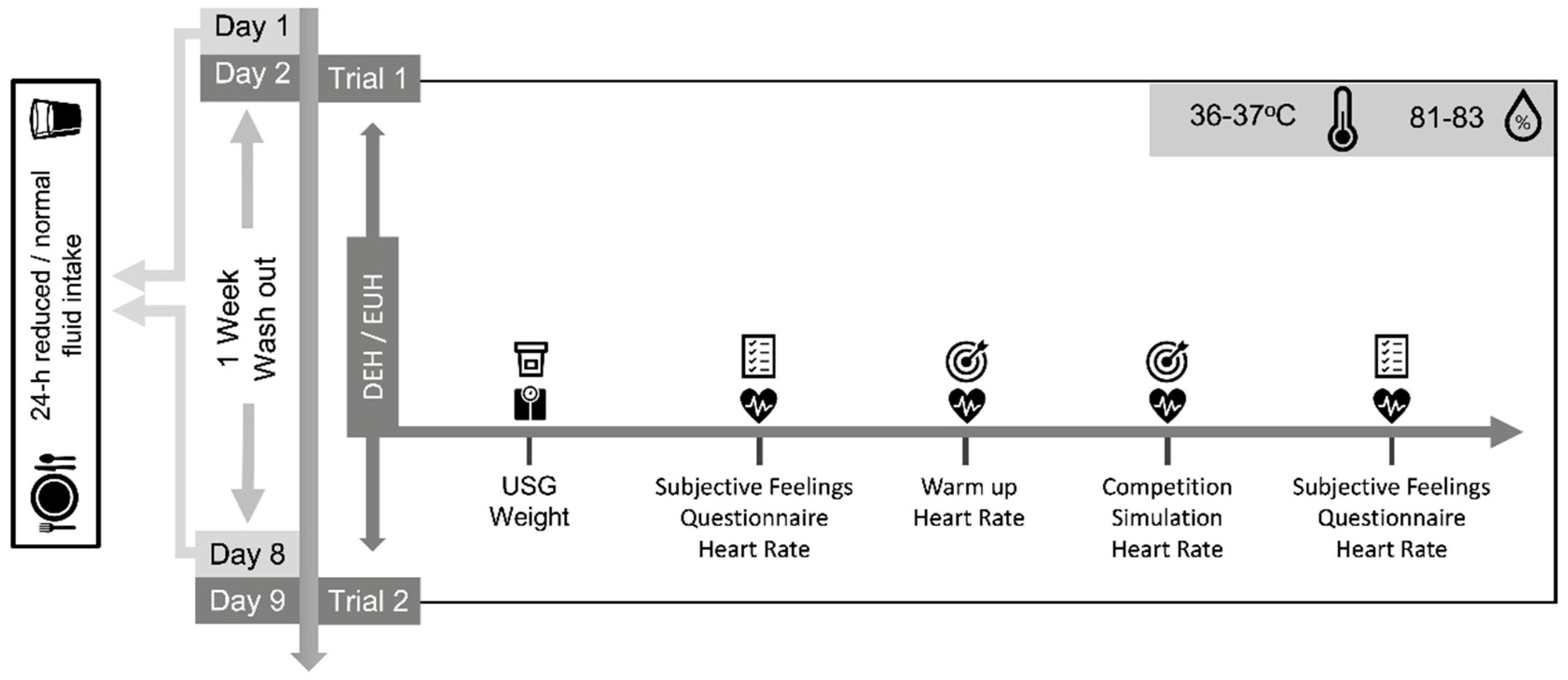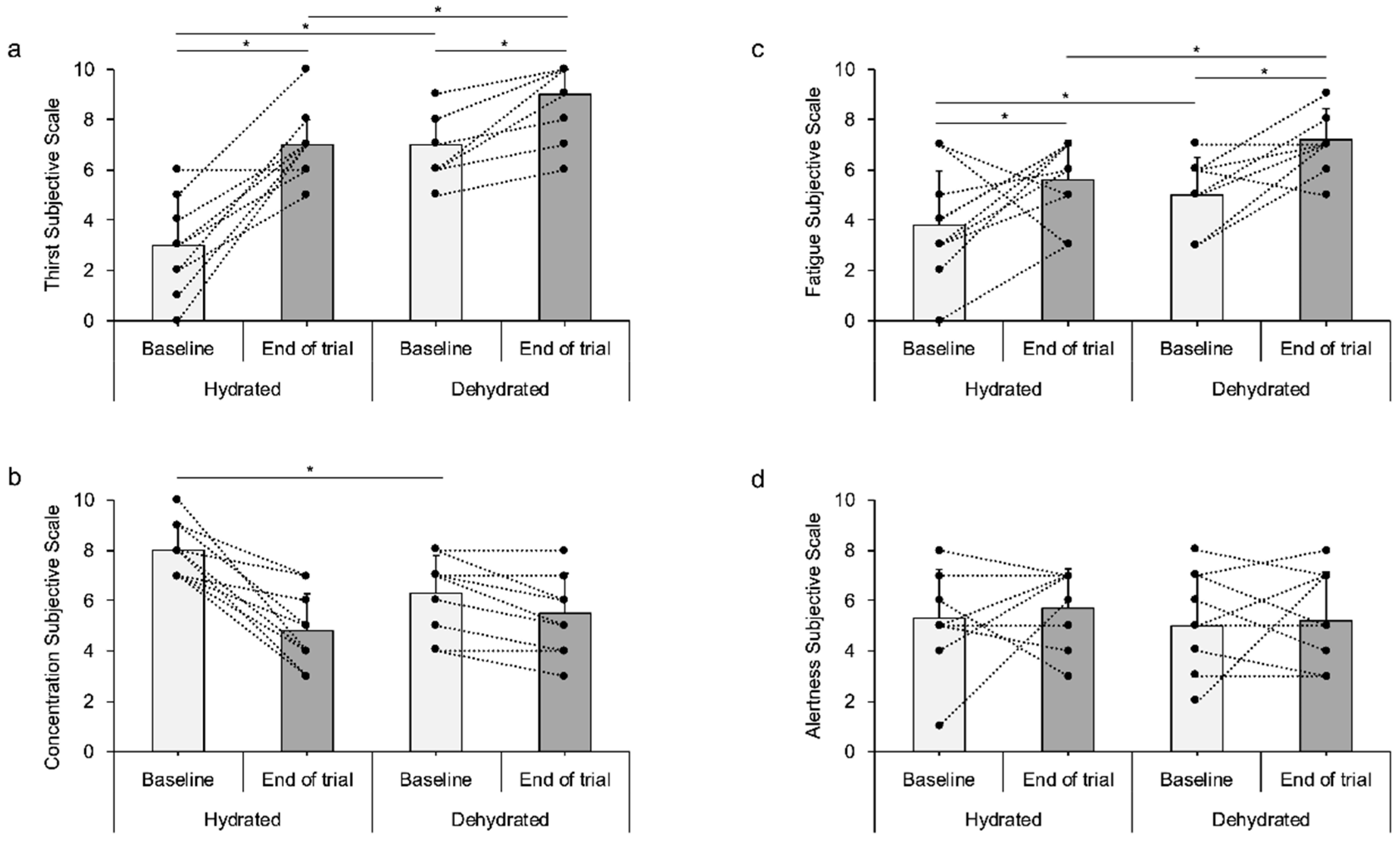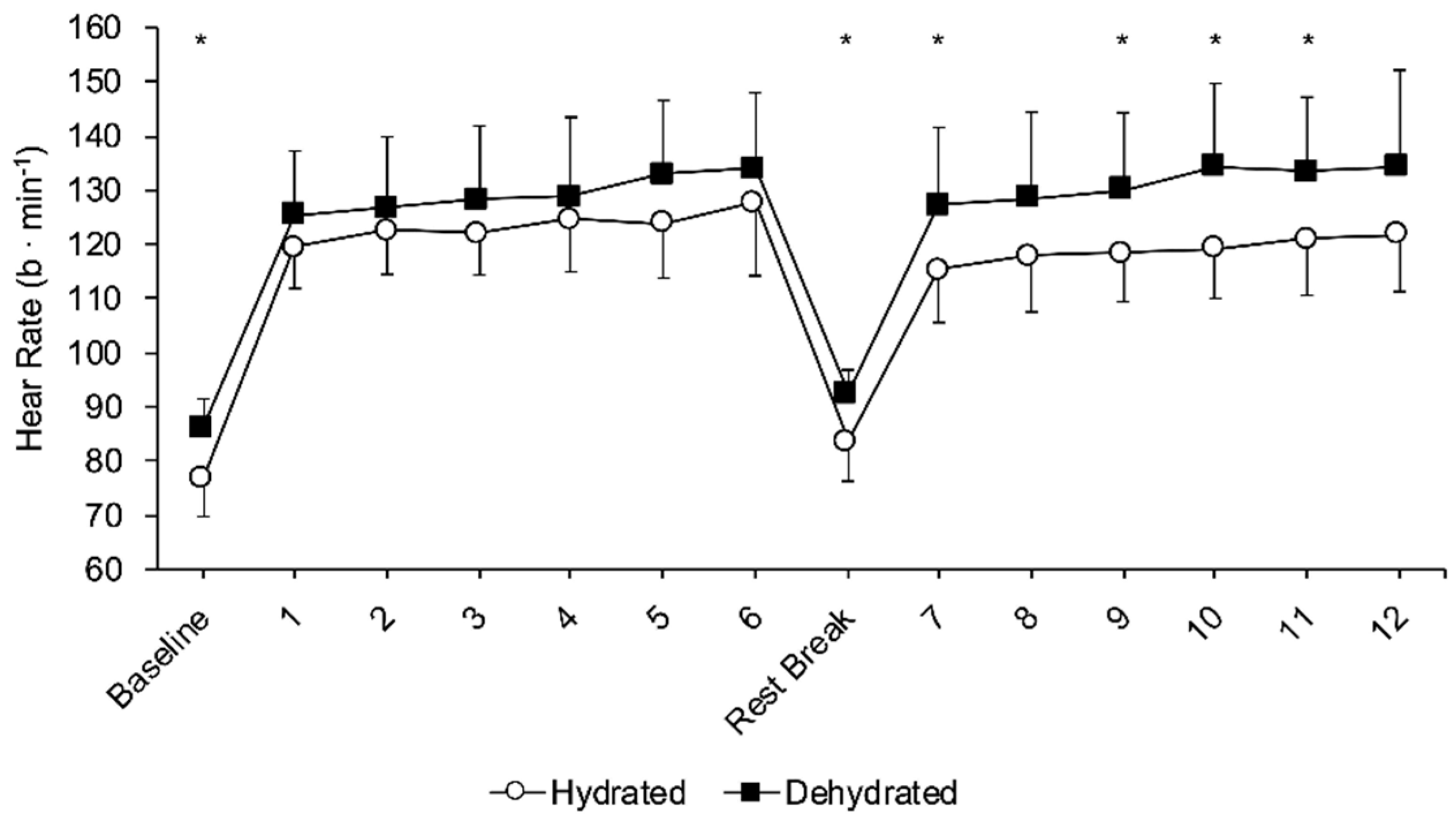Effects of Dehydration on Archery Performance, Subjective Feelings and Heart Rate during a Competition Simulation
Abstract
1. Introduction
2. Materials and Methods
2.1. Participants
2.2. Study Design
2.3. Fluid Restriction Protocol
2.4. Archery Competition Simulation Protocol
2.5. Anthropometrics
2.6. Hydration Status Assessment
2.7. Heart Rate Response
2.8. Subjective Feelings Monitoring
2.9. Statistical Analysis
3. Results
4. Discussion
5. Conclusions
Author Contributions
Funding
Conflicts of Interest
References
- Cheuvront, S.N.; Kenefick, R.W. Dehydration: Physiology, Assessment, and Performance Effects. Compr. Physiol. 2014, 4, 257–285. [Google Scholar] [CrossRef] [PubMed]
- Cheuvront, S.N.; Carter, R.; Sawka, M.N. Fluid Balance and Endurance Exercise Performance. Curr. Sports Med. Rep. 2003, 2, 202–208. [Google Scholar] [CrossRef] [PubMed]
- Green, J.M.; Miller, B.; Simpson, J.; Dubroc, D.; Keyes, A.; Neal, K.; Gann, J.; Andre, T. Effects of 2% Dehydration on Lactate Concentration During Constant-Load Cycling. J. Strength Cond. Res. Natl. Strength Cond. Assoc. 2018, 32, 2066–2071. [Google Scholar] [CrossRef] [PubMed]
- Armstrong, L.E.; Costill, D.L.; Fink, W.J. Influence of diuretic-induced dehydration on competitive running performance. Med. Sci. Sports Exerc. 1985, 17, 456–461. [Google Scholar] [CrossRef] [PubMed]
- Slater, G.J.; Rice, A.J.; Tanner, R.; Sharpe, K.; Jenkins, D.G.; Hahn, A.G. Impact of Two Different Body Mass Management Strategies on Repeat Rowing Performance. Med. Sci. Sports Exerc. 2006, 38, 138–146. [Google Scholar] [CrossRef] [PubMed]
- Nuccio, R.P.; Barnes, K.A.; Carter, J.M.; Baker, L.B. Fluid Balance in Team Sport Athletes and the Effect of Hypohydration on Cognitive, Technical, and Physical Performance. Sports Med. (Auckl. N. Z.) 2017, 47, 1951–1982. [Google Scholar] [CrossRef] [PubMed]
- Barley, O.; Chapman, D.W.; Blazevich, A.J.; Abbiss, C.R. Acute Dehydration Impairs Endurance without Modulating Neuromuscular Function. Front. Physiol. 2018, 9, 9. [Google Scholar] [CrossRef]
- Judelson, D.A.; Maresh, C.M.; Farrell, M.J.; Yamamoto, L.M.; Armstrong, L.E.; Kraemer, W.J.; Volek, J.S.; Spiering, B.A.; Casa, D.J.; Anderson, J.M. Effect of Hydration State on Strength, Power, and Resistance Exercise Performance. Med. Sci. Sports Exerc. 2007, 39, 1817–1824. [Google Scholar] [CrossRef]
- Lin, J.-J.; Hung, C.-J.; Yang, C.-C.; Chen, H.-Y.; Chou, F.-C.; Lu, T.-W. Activation and tremor of the shoulder muscles to the demands of an archery task. J. Sports Sci. 2010, 28, 415–421. [Google Scholar] [CrossRef]
- Shinohara, H.; Urabe, Y. Analysis of muscular activity in archery: A comparison of skill level. J. Sports Med. Phys. Fit. 2018, 58, 1752–1758. [Google Scholar] [CrossRef]
- Nishizono, H.; Nakagawa, K.; Suda, T.; Saito, K. An electromyographical analysis of purposive muscle activity and appearance of muscle silent period in archery shooting. Jpn. J. Phys. Fit. Sports Med. 1984, 33, 17–26. [Google Scholar] [CrossRef][Green Version]
- Gauchard, G.C.; Gangloff, P.; Vouriot, A.; Mallié, J.-P.; Perrin, P.P. Effects of exercise-induced fatigue with and without hydration on static postural control in adult human subjects. Int. J. Neurosci. 2002, 112, 1191–1206. [Google Scholar] [CrossRef] [PubMed]
- Carrillo, A.E.; Christodoulou, V.X.; Koutedakis, Y.; Flouris, A.D. Autonomic nervous system modulation during an archery competition in novice and experienced adolescent archers. J. Sports Sci. 2011, 29, 913–917. [Google Scholar] [CrossRef] [PubMed]
- Robazza, C.; Bortoli, L.; Nougier, V. Emotions, heart rate and performance in archery. A case study. J. sports Med. Phys. Fit. 1999, 39, 169–176. [Google Scholar]
- Helin, P.; Sihvonen, T.; Hänninen, O. Timing of the triggering action of shooting in relation to the cardiac cycle. Br. J. Sports Med. 1987, 21, 33–36. [Google Scholar] [CrossRef]
- Dieleman, N.; Koek, H.L.; Hendrikse, J. Short-term mechanisms influencing volumetric brain dynamics. NeuroImage Clin. 2017, 16, 507–513. [Google Scholar] [CrossRef]
- Kempton, M.J.; Ettinger, U.; Foster, R.; Williams, S.; Calvert, G.A.; Hampshire, A.; Zelaya, F.; O’Gorman, R.; McMorris, T.; Owen, A.M.; et al. Dehydration affects brain structure and function in healthy adolescents. Hum. Brain Mapp. 2010, 32, 71–79. [Google Scholar] [CrossRef]
- Ganio, M.S.; Armstrong, L.E.; Casa, U.J.; McDermott, B.P.; Lee, E.C.; Yamamoto, L.M.; Marzano, S.; Lopez, R.M.; Jimenez, L.; Le Bellego, L.; et al. Mild dehydration impairs cognitive performance and mood of men. Br. J. Nutr. 2011, 106, 1535–1543. [Google Scholar] [CrossRef]
- D’Anci, K.E.; Mahoney, C.R.; Vibhakar, A.; Kanter, J.H.; Taylor, H.A. Voluntary Dehydration and Cognitive Performance in Trained College Athletes. Percept. Mot. Ski. 2009, 109, 251–269. [Google Scholar] [CrossRef]
- Cheuvront, S.N.; Ely, B.R.; Kenefick, R.W.; Sawka, M.N. Biological variation and diagnostic accuracy of dehydration assessment markers. Am. J. Clin. Nutr. 2010, 92, 565–573. [Google Scholar] [CrossRef]
- Shirreffs, S.M.; Merson, S.J.; Fraser, S.M.; Archer, D.T. The effects of fluid restriction on hydration status and subjective feelings in man. Br. J. Nutr. 2004, 91, 951–958. [Google Scholar] [CrossRef] [PubMed]
- Martin, P.E.; Siler, W.L.; Hoffman, D. Electromyographic analysis of bow string release in highly skilled archers. J. Sports Sci. 1990, 8, 215–221. [Google Scholar] [CrossRef] [PubMed]
- Ertan, H.; Kentel, B.B.; Tümer, S.T.; Korkusuz, F. Activation patterns in forearm muscles during archery shooting. Hum. Mov. Sci. 2003, 22, 37–45. [Google Scholar] [CrossRef]
- Jones, L.C.; Cleary, M.A.; Lopez, R.M.; Zuri, R.E.; Lopez, R. Active Dehydration Impairs Upper and Lower Body Anaerobic Muscular Power. J. Strength Cond. Res. 2008, 22, 455–463. [Google Scholar] [CrossRef] [PubMed]
- Kim, H.-B.; Kim, S.-H.; So, W.-Y. The Relative Importance of Performance Factors in Korean Archery. J. Strength Cond. Res. 2015, 29, 1211–1219. [Google Scholar] [CrossRef] [PubMed]
- Wittbrodt, M.; Millard-Stafford, M. Dehydration Impairs Cognitive Performance: A Meta-analysis. Med. Sci. Sports Exerc. 2018, 50, 2360–2368. [Google Scholar] [CrossRef] [PubMed]
- Szinnai, G.; Schachinger, H.; Arnaud, M.J.; Linder, L.; Keller, U. Effect of water deprivation on cognitive-motor performance in healthy men and women. Am. J. Physiol. Integr. Comp. Physiol. 2005, 289, R275–R280. [Google Scholar] [CrossRef]
- Stavrinou, P.S.; Giannaki, C.D.; Andreou, E.; Aphamis, G. Prevalence of hypohydration in adolescents during the school day in Cyprus: Seasonal variations. East. Mediterr. Health J. 2020, 26. [Google Scholar] [CrossRef]
- Aphamis, G.; Stavrinou, P.; Andreou, E.; Giannaki, C.D. Hydration status, total water intake and subjective feelings of adolescents living in a hot environment, during a typical school day. Int. J. Adolesc. Med. Health 2019. [Google Scholar] [CrossRef]
- Gamage, J.P.; De Silva, A.P.; Nalliah, A.K.; Galloway, S.D. Effects of Dehydration on Cricket Specific Skill Performance in Hot and Humid Conditions. Int. J. Sport Nutr. Exerc. Metab. 2016, 26, 531–541. [Google Scholar] [CrossRef]
- Baker, L.B.; Dougherty, K.A.; Chow, M.; Kenney, W.L. Progressive Dehydration Causes a Progressive Decline in Basketball Skill Performance. Med. Sci. Sports Exerc. 2007, 39, 1114–1123. [Google Scholar] [CrossRef] [PubMed]
- Le Mansec, Y.; Pageaux, B.; Nordez, A.; Dorel, S.; Jubeau, M. Mental fatigue alters the speed and the accuracy of the ball in table tennis. J. Sports Sci. 2017, 36, 1–9. [Google Scholar] [CrossRef] [PubMed]
- Nybo, L.; Rasmussen, P.; Sawka, M.N. Performance in the Heat-Physiological Factors of Importance for Hyperthermia-Induced Fatigue. Compr. Physiol. 2014, 4, 657–689. [Google Scholar] [CrossRef] [PubMed]
- Chang, Y.; Lee, J.-J.; Seo, J.-H.; Song, H.-J.; Kim, Y.-T.; Lee, H.J.; Kim, H.J.; Lee, J.; Kim, W.; Woo, M.; et al. Neural correlates of motor imagery for elite archers. NMR Biomed. 2010, 24, 366–372. [Google Scholar] [CrossRef] [PubMed]
- Castro-Sepulveda, M.; Cerda-Kohler, H.; Pérez-Luco, C.; Monsalves-Alvarez, M.; Andrade, D.C.; Zbinden-Foncea, H.; Martín, E.B.-S.; Ramírez-Campillo, R. Hydration status after exercise affect resting metabolic rate and heart rate variability. Nutr. Hosp. 2014, 31, 1273–1277. [Google Scholar]
- Lakie, M. The influence of muscle tremor on shooting performance. Exp. Physiol. 2010, 95, 441–450. [Google Scholar] [CrossRef]
- Fenici, R.; Ruggieri, M.P.; Brisinda, D.; Fenici, P. Cardiovascular adaptation during action pistol shooting. J. Sports Med. Phys. Fit. 1999, 39, 259–266. [Google Scholar]
- Clemente, F.; Couceiro, M.; Rocha, R.; Mendes, R. Study of the Heart Rate and Accuracy Performance of Archers. J. Phys. Educ. Sport 2011, 11, 434–437. [Google Scholar]
- Sawka, M.N.; Burke, L.M.; Eichner, E.R.; Maughan, R.J.; Montain, S.J.; Stachenfeld, N.S. American College of Sports Medicine position stand. Exercise and fluid replacement. Med. Sci. Sports Exerc. 2007, 39, 377–390. [Google Scholar] [CrossRef]




© 2020 by the authors. Licensee MDPI, Basel, Switzerland. This article is an open access article distributed under the terms and conditions of the Creative Commons Attribution (CC BY) license (http://creativecommons.org/licenses/by/4.0/).
Share and Cite
Savvides, A.; D. Giannaki, C.; Vlahoyiannis, A.; S. Stavrinou, P.; Aphamis, G. Effects of Dehydration on Archery Performance, Subjective Feelings and Heart Rate during a Competition Simulation. J. Funct. Morphol. Kinesiol. 2020, 5, 67. https://doi.org/10.3390/jfmk5030067
Savvides A, D. Giannaki C, Vlahoyiannis A, S. Stavrinou P, Aphamis G. Effects of Dehydration on Archery Performance, Subjective Feelings and Heart Rate during a Competition Simulation. Journal of Functional Morphology and Kinesiology. 2020; 5(3):67. https://doi.org/10.3390/jfmk5030067
Chicago/Turabian StyleSavvides, Alexandros, Christoforos D. Giannaki, Angelos Vlahoyiannis, Pinelopi S. Stavrinou, and George Aphamis. 2020. "Effects of Dehydration on Archery Performance, Subjective Feelings and Heart Rate during a Competition Simulation" Journal of Functional Morphology and Kinesiology 5, no. 3: 67. https://doi.org/10.3390/jfmk5030067
APA StyleSavvides, A., D. Giannaki, C., Vlahoyiannis, A., S. Stavrinou, P., & Aphamis, G. (2020). Effects of Dehydration on Archery Performance, Subjective Feelings and Heart Rate during a Competition Simulation. Journal of Functional Morphology and Kinesiology, 5(3), 67. https://doi.org/10.3390/jfmk5030067







